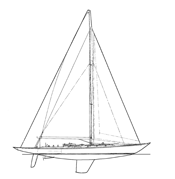Goshawk
2006 March 5
Classic racer-cruiser
Aesthetically you either like this style of boat or you don't. I can't see what's not to like unless you hate overhangs. The low freeboard and gentle sheer sweep of this design coupled with a relatively short and low cabintrunk make it a beauty in my eye. But you know me. I just have to nitpick and in this case I'd have preferred to see the edge of the cabintrunk less parallel to the sheerline. But I'm talking about lowering the front end of the house maybe one and a quarter inches. But that one and a quarter inch one way or the other is not going to reduce the "Wow!" factor of this boat when it pulls into the harbor. In our world of plain white, bloated tennis shoe-type boats, Goshawk will be a standout. Anywhere.
The hull shape shows 20 degrees of deadrise amidships and this deadrise stays almost constant toward the stern. There is a small amount of concavity or hollow in the sections amidships at the garboards and that concavity is reintroduced at the stern to give the transom a more pleasing shape. The modern shape of speed that you see on boats like the Melges 32 makes for a very ugly transom if you go with traditional rake. So while this concavity or hollow in the shape of Goshawk's transom may cost it a fraction of a knot in boatspeed, the aesthetic advantage is undeniable. The D/L of this design is 125. It's a light boat. There is a total of 22 feet, 9 inches devoted to overhangs. The L/B is 5.25
This is narrow. Anything over 4 is narrow. This may be the highest L/B I have ever measured in these reviews. For reference, consider an America's Cup boat will have an L/B around 6.34. The keel is a bulb on the bottom of a carbon fiber fin that doubles as a fuel tank. The capacity of this tank is 100 gallons. Draft is 10 feet, 6 inches. The rudder is all carbon fiber built by Composite Solutions Inc.
The interior is well laid out with three staterooms and two heads. The owner's stateroom in the bow has direct access to its own head. There is a quarterberth to starboard and a pilot berth to port over the settee. You could sleep six very comfortably in this layout and all six could sit together in the saloon and enjoy a meal together.
The rig is pretty standard other than the fact that there is provision for a staysail to be carried for heavy weather. The spars are carbon by GMT Composites. The SA/D is 25.6. You are going to need to work those runners to keep this rig tuned but with no overlap on the jibs you will probably be looking for something to do anyway. I like the way the headstay is pulled aft off the stem.
Hull construction is vacuum-bagged Port Orford Cedar longitudinal skins followed by carbon fiber outside over one-inch Core-Cell foam and two layers of Red Cedar at opposing 45-degree angles on the inside. The inner wood skin is covered in 10-ounce E glass. This is true composite construction that will result in a very light and stiff boat. Combining wood skins and carbon fiber in a laminate requires very careful engineering.
What a nice boat.

Comments